The University of California, Riverside College of Engineering Center for Environmental Research and Technology (CE-CERT) and SoCalGas have announced the results of a new study on ultra-low emission natural gas heavy-duty engines. The study found that a Los Angeles County Metropolitan Transit Agency (Metro) bus equipped with an ultra-low emission natural gas engine performs significantly cleaner than its certification standards across all duty cycles.
Researchers tested the Cummins Westport ISL G near zero natural gas engine in a variety of conditions typical of a Metro bus. In all conditions the engine performed even better than California’s toughest in the nation standard for smog-forming emissions. In some driving conditions emissions were practically zero.
“We have tested two of the ISL G near-zero 8.9 liter engines, one in a refuse hauler and one in a Metro bus. In both cases, the NOx emissions were surprisingly low and 99 percent cleaner than the current standard and 99.96 percent cleaner than the 2004 standard,” said Kent Johnson, associate research engineer for CE-CERT and lead researcher on this study. “The near-zero engine will provide immediate NOx relief to our region at a low cost, and coupled with renewable natural gas (RNG), would provide long-term stability to our energy and climate change needs. Pursuing RNG technology is a promising and visionary pathway for California and is recommended by UCR’s RNG research center.”
“The UC Riverside data suggests that this natural gas bus is as clean as an electric bus when it comes to meeting air quality standards,” said George Minter, regional vice president for external affairs and environmental strategy for SoCalGas. “And when these buses are fueled with renewable natural gas, the greenhouse gas reductions are even greater. By deploying this technology, large bus fleets like Metro’s have a tremendous opportunity to achieve clean air gains.”
Highlights of the study include:
- The engine tested below Environmental Protection Agency (EPA) NOx (smog-forming) emissions certification level of 0.2g/bhp-hr.
- The engine tested below the California Air Resources Board voluntary limit of 0.02 /bhp-hr. This is the only engine to meet the California standard.
- Emissions for some driving patterns, such as stop-and-go traffic were even lower still.
- In some driving conditions the bus tested as low as 0.0007g/bhp-hr, or practically zero emissions.
“This research is welcome news that the latest near-zero-emission natural gas engines are even cleaner than expected,” said Wayne Nastri, executive officer for the South Coast Air Quality Management District. “Since heavy-duty vehicles are the No. 1 source of smog-forming emissions in our region, deployment of this technology in our fleets is critically important for us to achieve our clean air goals.”
The California Air Resources Board set ambitious NOx inventory requirements by 2023 for the South Coast Air Basin in its Air Quality Management Plan. CARB’s air quality modeling shows achieving the 2023 standard will require an additional 70 percent reduction in NOx emissions from current standards. Heavy-duty natural gas vehicles can play a vital role in cleaning air in the South Coast today.


